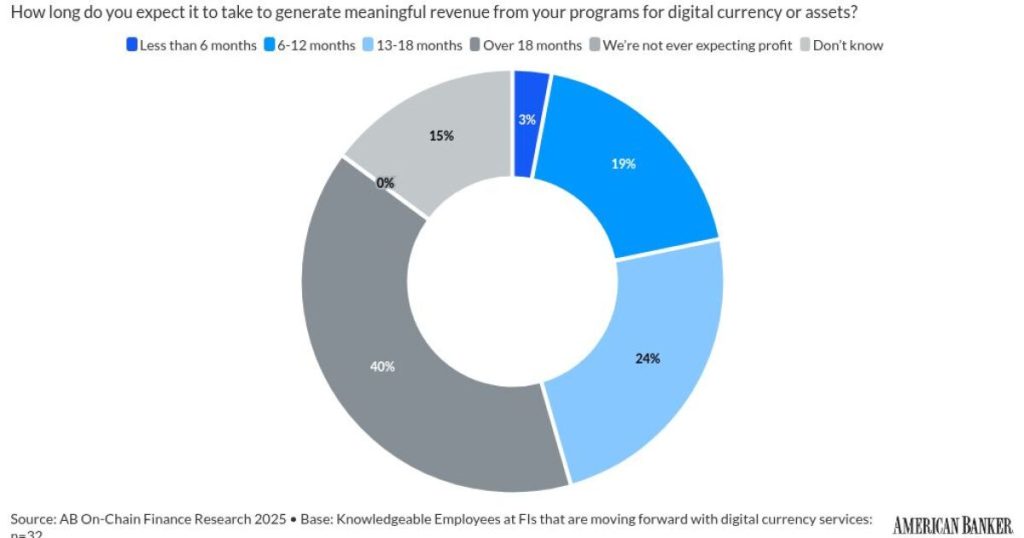American Banker’s 2025 On-Chain Finance Report
American Banker’s On-Chain Finance survey was fielded online during August and September, 2025, among 142 employees of banks, credit unions or payments companies. All respondents are knowledgeable about their institution’s plans for digital currencies, including cryptocurrencies and digital assets.
Top findings from the report
Results from the report are highlighted below using interactive charts. Mouse over each section for more detail, click on the chart labels to show or hide sections and use the arrows to cycle between chart views. This item is the latest in a series diving into new data from American Banker, so check back for the latest updates.
Return on investment
Diving deeper into their digital-asset strategies, roughly half of bank and credit union leaders expect to see returns on their programs within 18 months.
Three percent of professionals surveyed said they expect to generate meaningful revenue from their digital currency or asset programs in less than six months, while 19% expect the same result in six to twelve months and 24% in 13 to 18 months.
The largest single share of respondents, at 40%, expect to see revenue after 18 months. Fifteen percent were unsure of their organization’s expectations for revenue generation from digital-asset programs.
Key takeaway: While 46% of respondents expect to see meaningful revenue from their organizations’ digital asset programs within 18 months, 40% predict earnings are further out.
Section 2
Crypto infrastructure planning

When building the framework for supporting cryptocurrency and digital-asset programs, banks and credit unions are inviting outside partners to work alongside their in-house experts.
Only 6% percent of respondents said their organizations were building the technical infrastructure wholly in-house, while an equal share of those surveyed said the strategy involved acquiring or merging with another organization that has the necessary technology.
The broad majority of respondents are involving outside subject-matter experts to build supporting infrastructure to some degree.
Twenty-two percent are mostly building frameworks in-house with some third-party partnerships, followed by 34% that are adopting an equal mix of outside and in-house experts and 38% who are leaning more heavily on third-party organizations.
Key takeaway: Financial institutions building out the frameworks for digital asset programs are mainly relying on outside experts for help.
Section 3
The pairing of KYC and crypto

KYC protocols can be a vulnerability for traditional banking services if they’re not developed and implemented properly. The same logic may apply to KYC in crypto programs.
Fifty percent respondents said their organizations were adapting existing KYC frameworks for use in stablecoin programs, and a separate 50% said their organizations were spinning up specialized compliance teams in-house to oversee the programs.
Forty-seven percent were enlisting the help of partners in the cryptocurrency industry to lend insight into crypto KYC protocols and standards, while 13% were doing the same with partners outside the crypto industry.
Seven percent of respondents were unsure how their organizations were handling KYC in cryptocurrency and/or digital-asset programs.
Key takeaway: Similar to building frameworks, many FIs are turning to outside subject-matter experts for handling the execution of KYC.
Section 4
Implementing anti-money laundering defenses

Close to 60% of respondents said that when overseeing anti-money laundering protocols in cryptocurrency and digital asset programs, it’s best to use what what they already have.
Fifty-nine percent of those surveyed are adapting their organization’s existing AML frameworks for use in stablecoin programs, while 41% said they plan to build a specialized compliance team in-house.
About 38% of respondents are using crypto industry partners to oversee the AML component of their digital-asset programs, and 25% are using non-crypto industry partners to the same end.
Six percent of experts surveyed said they were unsure how their organizations were handling AML.
Key takeaway: Most financial institutions are adapting their existing compliance frameworks for digital-asset programs.
Section 5
Weighing the risks of crypto fraud

Fraud is the top worry among financial institutions engaging with cryptocurrencies and digital assets.
Roughly 70% of respondents said fraudulent transactions were the biggest risk they were worried about in their crypto and digital-asset programs.
Volatility of the industry was the No. 2 recorded risk at 63%, followed by cyberattacks at 56%, level of required tech investment at 53% and running afoul of regulators at 47%.
Other noteworthy risks include uncertain return on investment (38%), level of competition in the crypto industry (31%, assets required to back digital-asset programs (22%) and customer losses (19%).
Key takeaway: Fraudulent transactions are a bigger worry for bankers than the volatility of cryptocurrency and running afoul of regulators.

